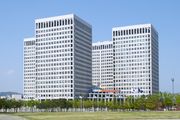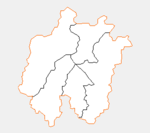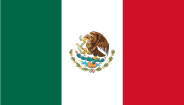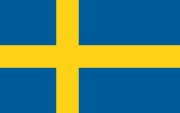Daejeon
| Daejeon 대전 大田 |
|||
|---|---|---|---|
| — Metropolitan City — | |||
| Daejeon Metropolitan City | |||
| transcription(s) | |||
| - Hangul | 대전광역시 | ||
| - Hanja | 大田廣域市 | ||
| - Revised Romanization | Daejeon-gwangyeoksi | ||
| - McCune-Reischauer | Taejŏn-kwangyŏksi | ||
 |
|||
|
|||
 |
|||
| Country | |||
| Region | Hoseo | ||
| Districts | 5 | ||
| Government | |||
| - Mayor | Yum Hong-chul | ||
| Area | |||
| - Total | 539.84 km2 (208.4 sq mi) | ||
| Population (2007) | |||
| - Total | 1,442,857 | ||
| - Density | 2,673/km2 (6,923/sq mi) | ||
| - Dialect | Chungcheong | ||
| Flower | White magnolia | ||
| Tree | Pine | ||
| Bird | Korean magpie | ||
| Website | metro.daejeon.kr (English) | ||
Daejeon (listen; Korean pronunciation: [tɛdʑʌn]) is located in the center of South Korea. It is the fifth largest city in South Korea, with a population of 1,442,856 at the end of 2005.[1] It is at the crossroads of Gyeongbu railway, Honam railway, Gyeongbu Expressway, and Honam Expressway. Within the city limits lies Daedeok Science Town, an area with more than 200 research institutions.
Contents |
History

The Daejeon area was historically known as Hanbat (한밭), a native Korean term for "large field", during the Joseon Dynasty. The term "Daejeon" simply means the same thing in Hanja.
Historically, Daejeon was a small village without many residents. However, in 1905, the Gyeongbu railway began operations from Seoul to Busan, opening a station at Daejeon. Soon after, in 1926, under rule of the Japanese government, the Honam railway was built between Daejeon and Mokpo, transforming the latter into a major transportation hub. Because of its geographical location and proximity to means of transportation, Daejeon grew quickly.
In 1932, the capital of Chungnam province was moved from Gongju to Daejeon. During the Korean War, the city was the site of an early major battle of the war, the Battle of Taejon.
Since then numerous changes have been made to the city boundaries. Among the boundary modifications include one that effectively made the nearby town of Daedeok a part of the city in 1983. Daejeon was designated in 1995 as a metropolitan city.
In 1997, the Daejeon Government Complex was constructed as part of an effort to move some government offices away from the densely populated capital, Seoul.[2] The population of Daejeon increased dramatically as a result.[3]
Today, Daejeon's population growth is the second highest in the country, after Seoul, resulting in a large number of new apartment complex projects and high-tech industries in Yuseong-gu.
Geography

Daejeon lies between latitudes N36°10'50" to N36°29'47" and longitudes E127°14'54" to E127°33'21" near the middle of South Korea. It is 167.3 km from Seoul, 294 km from Busan and 169 km from Gwangju. Sejong City, which is planned to be the new administrative capital of South Korea, will also be close by. The city is surrounded by several mountains, and Gyeryongsan National Park straddles the city border to the west. Three streams which eventually join with Geum River, called Gapcheon (갑천), Yudeungcheon (유등천), and Daejeoncheon (대전천), flow through the city from south to north.
Climate
| Climate data for Daejeon, South Korea (1971-2000) | |||||||||||||
|---|---|---|---|---|---|---|---|---|---|---|---|---|---|
| Month | Jan | Feb | Mar | Apr | May | Jun | Jul | Aug | Sep | Oct | Nov | Dec | Year |
| Average high °C (°F) | 3.3 (37.9) |
5.7 (42.3) |
11.5 (52.7) |
19.1 (66.4) |
23.8 (74.8) |
27.4 (81.3) |
29.7 (85.5) |
30.2 (86.4) |
25.9 (78.6) |
20.4 (68.7) |
12.7 (54.9) |
6.1 (43) |
18.0 (64.4) |
| Daily mean °C (°F) | -1.9 (28.6) |
0.2 (32.4) |
5.4 (41.7) |
12.4 (54.3) |
17.6 (63.7) |
22.0 (71.6) |
25.3 (77.5) |
25.5 (77.9) |
20.3 (68.5) |
13.8 (56.8) |
6.8 (44.2) |
0.7 (33.3) |
12.3 (54.1) |
| Average low °C (°F) | -6.3 (20.7) |
-4.5 (23.9) |
0.2 (32.4) |
6.3 (43.3) |
11.7 (53.1) |
17.2 (63) |
21.8 (71.2) |
21.8 (71.2) |
15.8 (60.4) |
8.3 (46.9) |
1.9 (35.4) |
-3.9 (25) |
7.5 (45.5) |
| Precipitation mm (inches) | 29.5 (1.161) |
36.4 (1.433) |
60.5 (2.382) |
87.2 (3.433) |
97.0 (3.819) |
174.3 (6.862) |
292.2 (11.504) |
296.5 (11.673) |
141.5 (5.571) |
56.9 (2.24) |
51.7 (2.035) |
30.1 (1.185) |
1,353.8 (53.299) |
| % Humidity | 68.9 | 66.0 | 63.8 | 61.6 | 65.8 | 73.2 | 80.1 | 79.8 | 77.6 | 73.7 | 73.4 | 71.8 | 71.3 |
| Sunshine hours | 156.7 | 161.0 | 196.4 | 220.6 | 237.7 | 200.3 | 168.2 | 188.0 | 186.5 | 201.3 | 153.2 | 151.1 | 2,221.0 |
| Source: [4] | |||||||||||||

Administrative divisions
Daejeon is divided into 5 wards ("Gu"):
Central business district


The middle of the city or the new central business district called Dunsan is where the effort has manifested itself. Newer apartment complexes, albeit structurally similar to that of the rest of the city, sprung up around the new government structures being constructed concurrently in just a few short years starting from the mid-1990s. Newer municipal buildings including the city's courts and the province's main parliamentary building soon followed. The result is a several square mile neighbourhood full of restaurants, standard Korean western-type bars and coffee shops. The area is a place for the workers of the new Daejeon to live close to their offices, most able to walk to work, and dine and shop in a new urban environment.
Education
Being known as the Silicon Valley of Korea, Daejeon is home of various private and public Research Institutes, Centers and Science parks (i.e. R&D centers of Samsung, LG, Korea University of Science and Technology & others are located within Daedeok Science Town in Yuseong-gu.
The Korea Advanced Institute of Science and Technology is an institution of higher education focused on research in science and technology, and was ranked as the best Asian science and technology school by Asiaweek in 2000.[5] Daejeon Science High School, which is a selective high school focused on teaching science.[6]
Chungnam National University, a major national university established for the South Chungcheong province, and Pai Chai University, which is one of the oldest private universities in South Korea, are also located within the city.
Hannam University, located in O-Jeong Dong, is another university in the city. It has plans to expand its campus in the next couple years as it has purchased neighboring Taejon Christian International School.
Research and Development
Daejeon features a technology cluster known as Daedeok Innopolis defined by the national Universities KAIST and Chungnam National University and surrounded by government research institutes, government-invested corporate research institutes, corporate research centers and venture companies. The mutual stimulation and cooperation between these communities produces remarkable innovation and commercialization of available technologies. When the Boston Consulting Group released recently a list of nations leading in innovation, Korea was ranked number two, just below Singapore.
Daedeok Innopolis derives its power from its ability to effectively innovate, an organic and fluid ecosystem for creativity . The research institutes and universities in Daedeok Valley have spun off multiple start-ups and continue to do so at a remarkable pace. Korea has invested heavily in building up both the research expertise for over thirty years, creating long-term research programs of scale and depth. There are over seven thousand with Ph.Ds in the sciences in Daedeok and state-of-the-art infrastructure is in place that enables Daedeok to play a leading role in the world.
The engine driving Daedeok is the organic circulation of ideas about technology and business between policy makers, researchers and businessmen working in the fields of telecommunications, nanofabrication, biotechnology, water, nuclear and hydro power, nuclear fusion, design, measurement technologies, mechanical engineering, fuel cells, aeronautics, new materials, robotics, new drugs and environmental technologies. Daedeok is exceptionally well endowed in all these fields and is expanding its international ties rapidly. Daedeok Innopolis' membership includes 898 corporations, 35 government invested and sponsored institutions; 6 universities; 15 public organizations.
Among Daedeok Innopolis' universities KAIST (Korea Advanced Institute of Science and Technology) is considered the top technical university in Korea. Strong fields at KAIST include computer science, electrical and nuclear engineering, mechanical design, chemistry and telecommunications. The national university Chungnam University also plays a central role in those fields, but brings also focused expertise in biotechnology, medicine and the agricultural sciences. These universities are complemented by such outstanding universities as Hanbat University (a leader in IT), Pai Chai University, Hannam University, Mokwon University and Woosong University.
Research institutes in Daedeok include the Korea Research Institute of Bioscience and Biotechnology (KRIBB), the Korea Atomic Energy Research Institute (KAERI), Electronic and Telecommunications Research Institute (ETRI), the Korea Aerospace Research Institute (KARI), National Fusion Research Institute, National Nanofab Center, Korean Basic Science Research Institute, Korea Institute of Machinery and Materials, Korea Research Institute of Chemical Technology, Korea Institute of Science and Technology Information, Korea Research Institute of Standards and Science, Marine and Ocean Engineering Research Institute, Institute for information Technology Advancement, Korea Institute of Geosciences and Mineral Resources, Korea Institute of Energy Research, Agency for Defense Development, Korea Institute of Toxicology, Korea Institute of Oriental Medicine, Korea Institute of Nuclear Non-proliferation and Control, National Institute for Mathematical Sciences, Korea Institute of Nuclear Safety and the National Security Research Institute. Among the outstanding technology produced in Daedeok are ETRI's wireless communications systems CDMA, WIBRO & DMB, KRIBB's nano biochips, KARI's KOMPSTAT satellites and NFRI's KSTAR nuclear fusion reactor.
Daedeok is also home to twenty-one corporate research centers with global reach surrounded by an equal number at smaller firms. Some of the notable corporate research centers are Dongbu Advanced Research Institute, (biotechnology, microorganisms and agrichemicals), GS-Caltex Value Creation Center (environmentally friendly products including substitutes for oil), Hanwha Chemical Research (biotechnology, electronics materials, catalysts & nanotechnology), Honam Petrochemical Daeduk Research Institute (synthetic chemistry & petrochemicals), LG Chemical LTD. Research Park (Lithium Ion Battery & Polymer Battery Development), Samyang R&D Center (medical Research and electronics) and SK Institute of Technology (petroleum-related research).
Also such public corporation research institutes as Korea Electric Power Research Institute (hydroelectric projects and nuclear energy), Korea Institute of Construction Materials (authorized test agency for construction materials), Korea Institute of Aerospace Technology (aerospace design, satellites, launch technologies) are also part of the Daedeok ecosystem.
The cross-fertilization between research fields in Daedeok encourages innovation and collaboration. Over the last 15 years, venture companies have sprung up like mushrooms after a spring rain, numbering over 800 at last count. Some of those companies have gone on to become major players and others are coming of age today.
The city supports one of the fastest developing business communities with a strong emphasis on technological innovation. The recently opened Daedeok Techno Valley on the north side of town brings together research with light manufacturing to create a unique environment for R&D. The universities and research institutes have set up venture firms here to explore new applications of their technologies. More recently, Daejeon's ACTS (Agency of Advanced Cultural Technologies and Services) has become a Mecca for multimedia entertainment and film. In October 2009 a new Daedeok Innopolis Business hub will open.
Culture
Parks
.jpg)
In 1993, an international exposition (Expo '93) was held at Daejeon. Several landmarks such as the Hanbit Tower and the Expo Bridge were built at this time. After the exposition ended, the grounds were refurbished as Expo Science Park. Next to the park is the National Science Museum, which had moved to its current location in 1990.[7]
There are eight good places for sight seers which are designated by city government.[8] Those are The Eight Sights Sikjangsan (Mt.), Bomunsan (Mt.), Gubongsan (Mt.), Jangtaesan (Mt.), Yuseong Spa, EXPO Park, Daecheonghosu (Lake), and Gyejoksan (Mt.).
Most of the cultural centres and sight seeing places are located in Yuseong-gu district with the exception of Ppuri park and Daejeon Zoo.
Arts
The Daejeon Museum of Art, located in Dunsan Grand Park, is an art museum focused on the convergence of art and technology. Since it was established in 1998, numerous exhibitions on contemporary art have been held. Another important cultural institution is the Daejeon Philharmonic Orchestra, which performs in Daejeon Culture & Arts Center and other local venues, and which recently completed several international tours, including visits to the United States and Japan.
Sports
The Daejeon World Cup Stadium was constructed in preparation for the 2002 FIFA World Cup. Several games have been held there, including the South Korea vs. Italy match in the second round. It is also the current home for the K-League football club Daejeon Citizen, and National League side Daejeon Hydro & Nuclear Power FC. Daejeon also hosts amateur football club Daejeon de la Cuba, which plays in the Super Sunday Football League.
The city is home to LPGA golfers Se Ri Pak and Jang Jeong. Daejeon is also the hometown of former New York Mets left-handed reliever Dae-Sung Koo.
The Hanhwa Eagles of the KBO play their home games at Daejeon Baseball Stadium in Busa-dong.
Media
Daejeon is a provincial center for the television, newspaper and publishing industries.
In Daejeon, major television broadcasting companies such as KBS, MBC have branches. TJB is a local television broadcaster based in Daejeon. In most apartments, cable TV services are available. 8 channels of Mobile TV are provided with the digital radio channels. Several FM radio stations provide news and music on the air. KBS, MBC, TJB have their FM radio channels, there are Christian radio channels, FEBC and CBS, and traffic news channel TBN.
Daejeon ilbo is a local newspaper which covers South Chungcheong province.
Transportation

Daejeon is a center of transportation in South Korea, where two major expressways, Gyeongbu Expressway and Honam Expressway, and two major railways, Gyeongbu railway and Honam railway, are joined. Travel time between Daejeon and Seoul using the high-speed railway system, otherwise known as KTX, is about fifty minutes. The nearest airport to Daejeon is Cheongju Airport, about a thirty-minute drive north of Daejeon.
Subway
One line, Daejeon Subway Line 1, of a planned five-line subway system has been operating since April 17, 2007 (partial operations on this line began on March 16, 2006). This subway line connects Daejeon station, located in the original city center, with the more modern and more recently developed sections of this city, including Dunsan, where the city hall and a number of national government buildings are located.
Notable differences between the Daejeon subway and the Seoul subway include narrower cars, no doors connecting cars, four cars per train rather than ten, and storage space under the seats for use by passengers.[9] The subway also uses round plastic tokens instead of the flat, magnetic paper tickets used in Seoul. The tokens are read by a proximity sensor when entering the turnstiles, and then inserted into a slot when exiting. The design of the tokens allows them to be used for advertising.[10] Platform screen doors are installed in the subway stations.
Notable people
- Shin Chaeho
- Se Ri Pak
- Ivy (singer)
- Shin Seung Hun
- Kwon Sang-woo
- Han Eun-jeong
- Hong Jin-Ho
Sister cities
 Oda, Japan — 1987
Oda, Japan — 1987 Seattle, United States — 1989
Seattle, United States — 1989 Budapest, Hungary — 1994
Budapest, Hungary — 1994 Nanjing, China — 1994
Nanjing, China — 1994 Calgary, Canada — 1996
Calgary, Canada — 1996 Guadalajara, Mexico — 1997
Guadalajara, Mexico — 1997 Uppsala, Sweden — 1999
Uppsala, Sweden — 1999 Novosibirsk, Russia — 2001
Novosibirsk, Russia — 2001 Brisbane, Australia — 2002
Brisbane, Australia — 2002 Binh Duong, Vietnam — 2005
Binh Duong, Vietnam — 2005
Independent cities in South Korea
See also
- List of cities in South Korea
- List of Korea-related topics
References
- ↑ "Population, Households and Housing Units". Korean Statistical Information System. Korea National Statistical Office. http://kosis.nso.go.kr/cgi-bin/sws_999.cgi?ID=DT_1IN0502&IDTYPE=3&A_LANG=2&FPUB=3&SELITEM=0. Retrieved 2007-02-28.
- ↑ "Daejeon Government Complex". Government Buildings Management Service. http://www.chungsa.go.kr/chungsa/cms/7/1/3/1/1.html. Retrieved 2007-02-22.
- ↑ Oh, Changyeop (2006-03-22). "Daejeon, Larger Population than Gwangju" (in Korean). Prometheus. http://www.prometheus.co.kr/articles/113/20060322/20060322151300.html. Retrieved 2007-02-22. "이러한 대전의 인구증가 요인은 지난 1998년 정부 대전청사 이전과 철도시설공단, 행정중심복합도시 건설청 등이 자리를 잡은 것과 관련이 있다."
- ↑ "평년값(30년 평균) 자료". Korea Meteorological Administration. http://www.kma.go.kr/sfc/sfc_03_05.jsp.
- ↑ "Asia's Best Universities 2000". Asiaweek. 2000-06-30. http://www.asiaweek.com/asiaweek/features/universities2000/scitech/sci.overall.html. Retrieved 2007-02-21.
- ↑ "Daejeon Science High School" (in Korean). http://www.djs.hs.kr/. Retrieved 2007-02-21. High schools in South Korea usually do not require special entrance exams.
- ↑ "History". National Science Museum of Korea. http://www.science.go.kr/center/eng/html/guide/guide_c__0010.html. Retrieved 2007-02-28.
- ↑ 8 good places
- ↑ "Riding Daejeon Subway" (in Korean). iris's talk on above 18 & computers & and society. 2006-05-08. http://myiris.egloos.com/2409333. Retrieved 2007-02-28.
- ↑ "Visiting Daejeon Subway" (in Korean). Korean Faction. 2006-03-17. http://kfaction.egloos.com/1633853. Retrieved 2007-02-28. "뒷면에는 대전소재 배재대학교의 광고가 새겨져있었습니다."
External links
- Daejeon Metropolitan Government
- Daejeon Compass
- Socius (website for internationals
- Daejeon : Official Site of Korea Tourism Org
|
|||||
|
||||||||||||||||||||
|
|||||||||||||||||||

